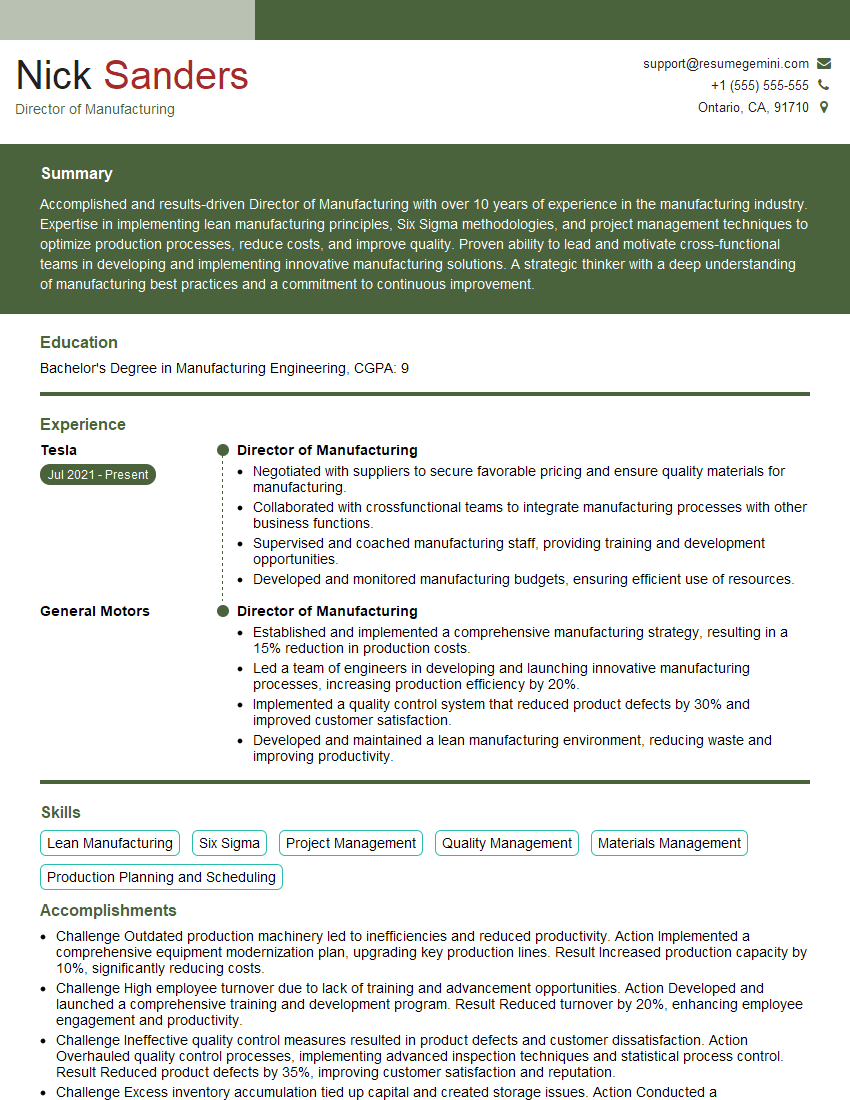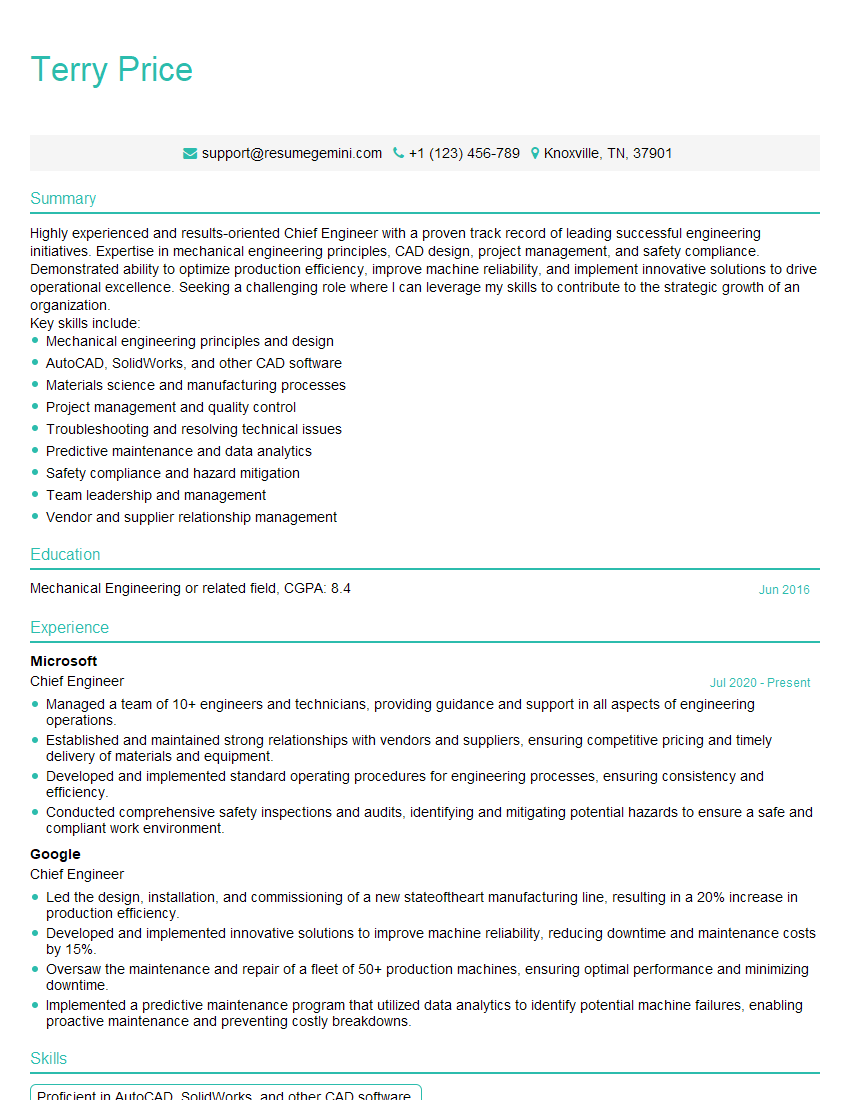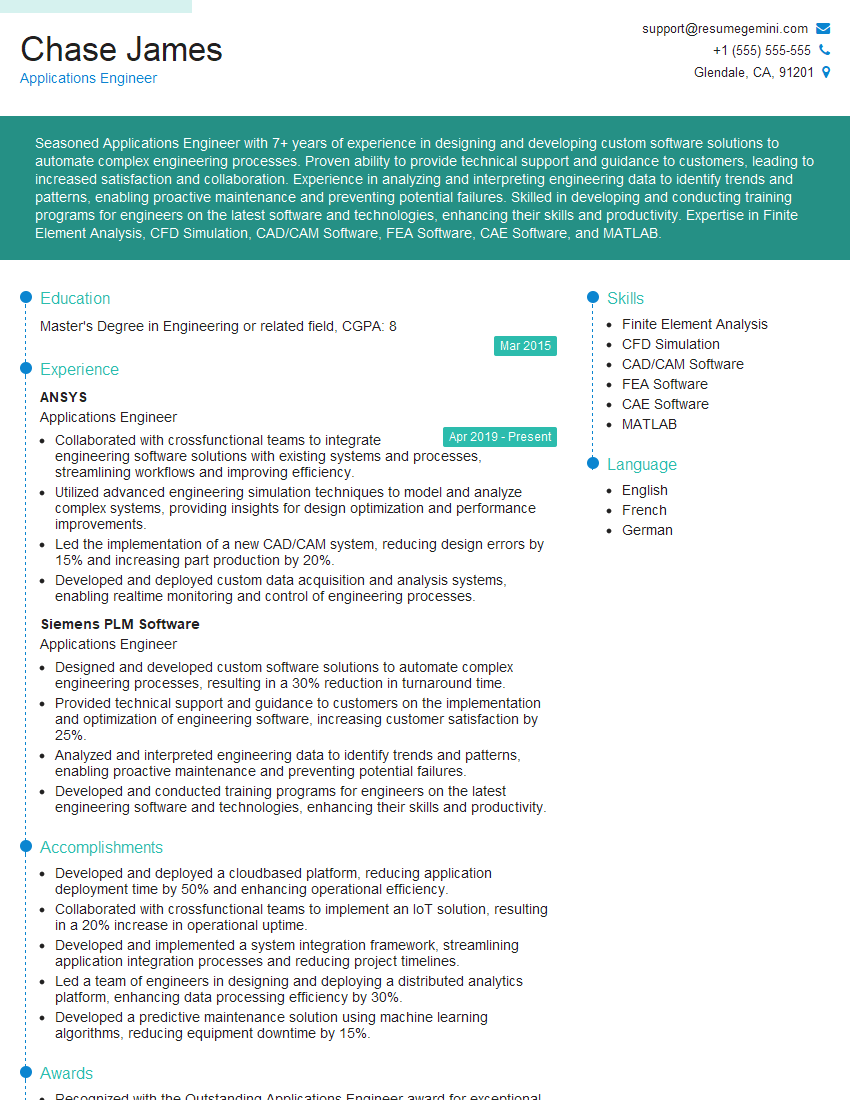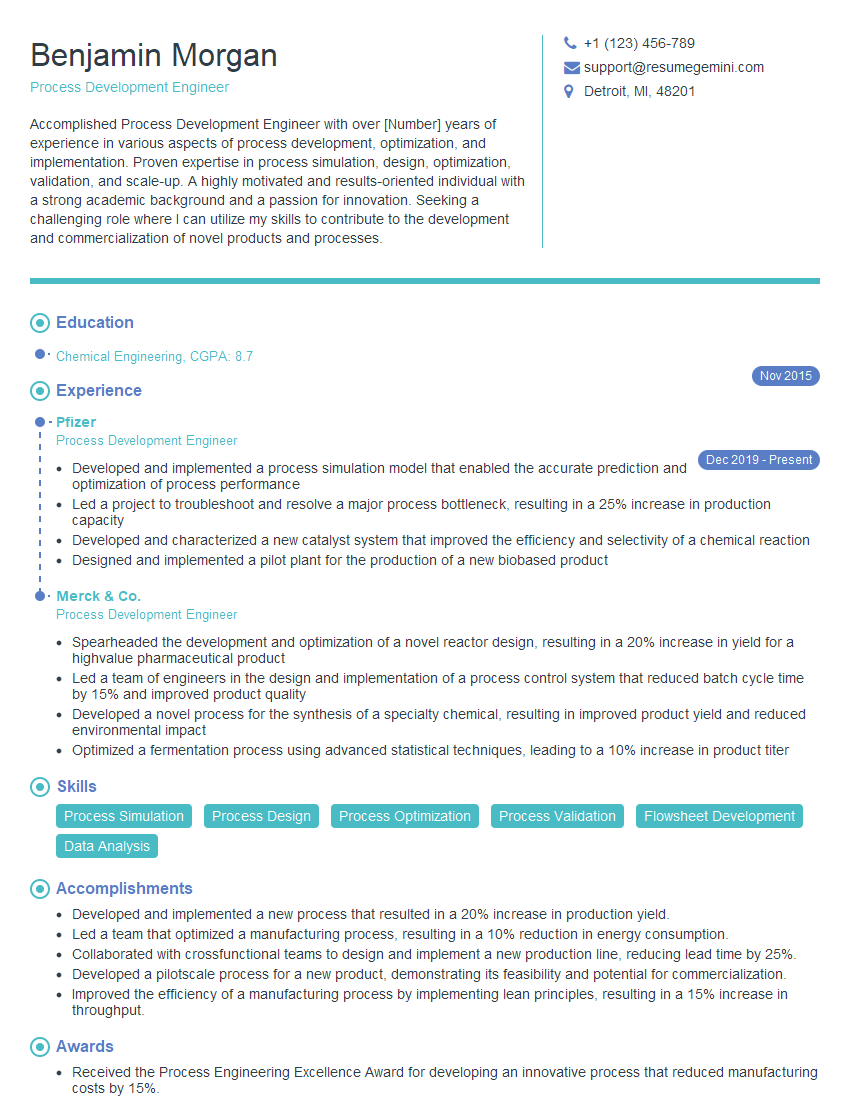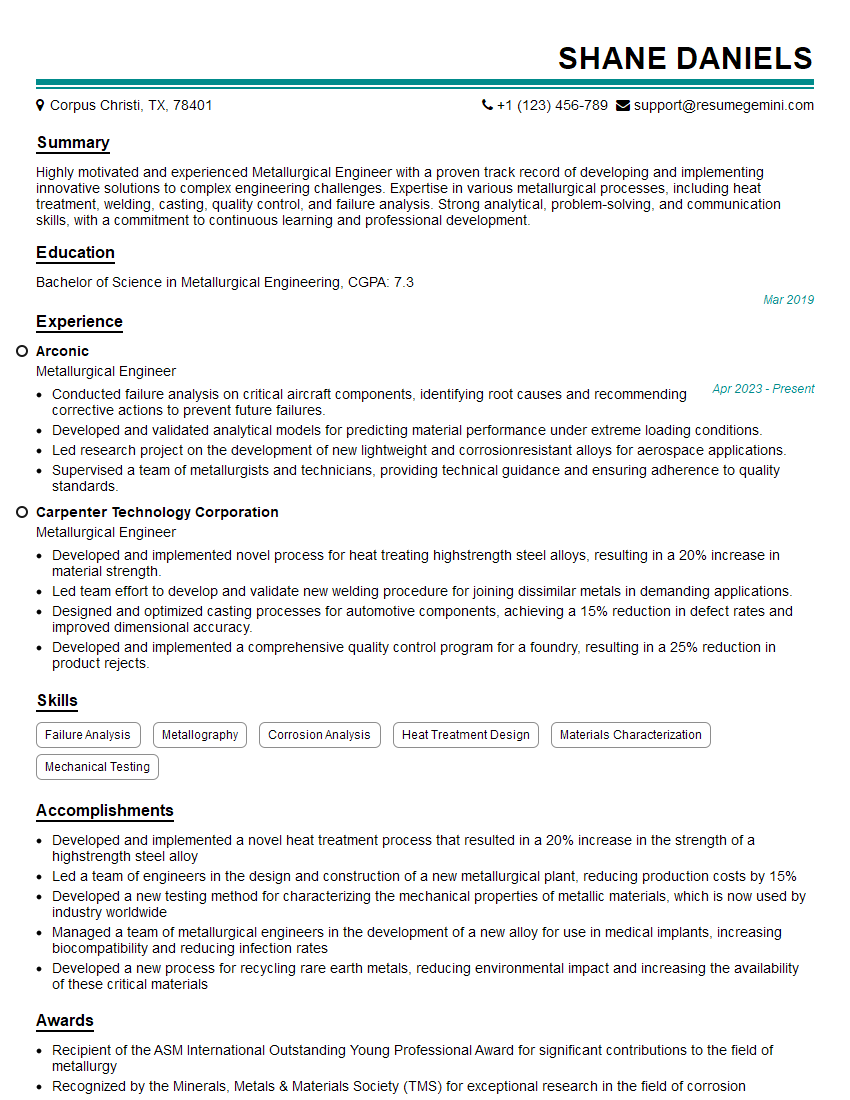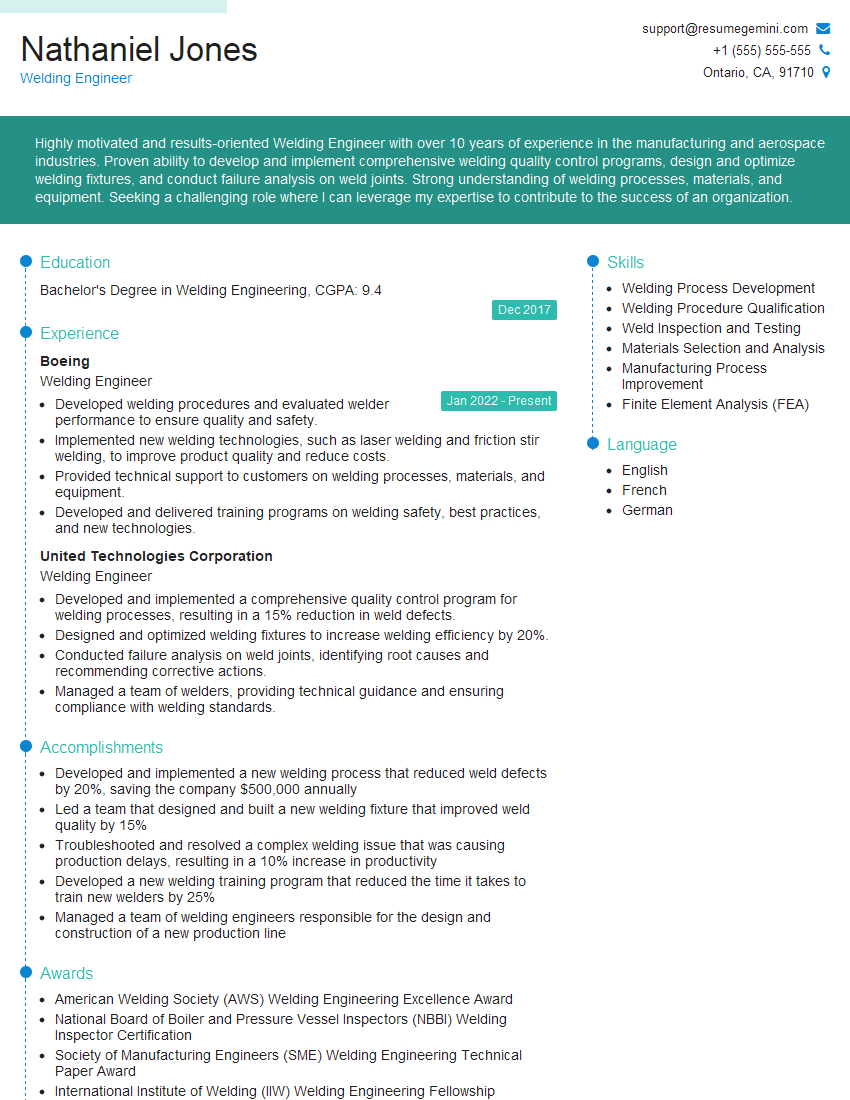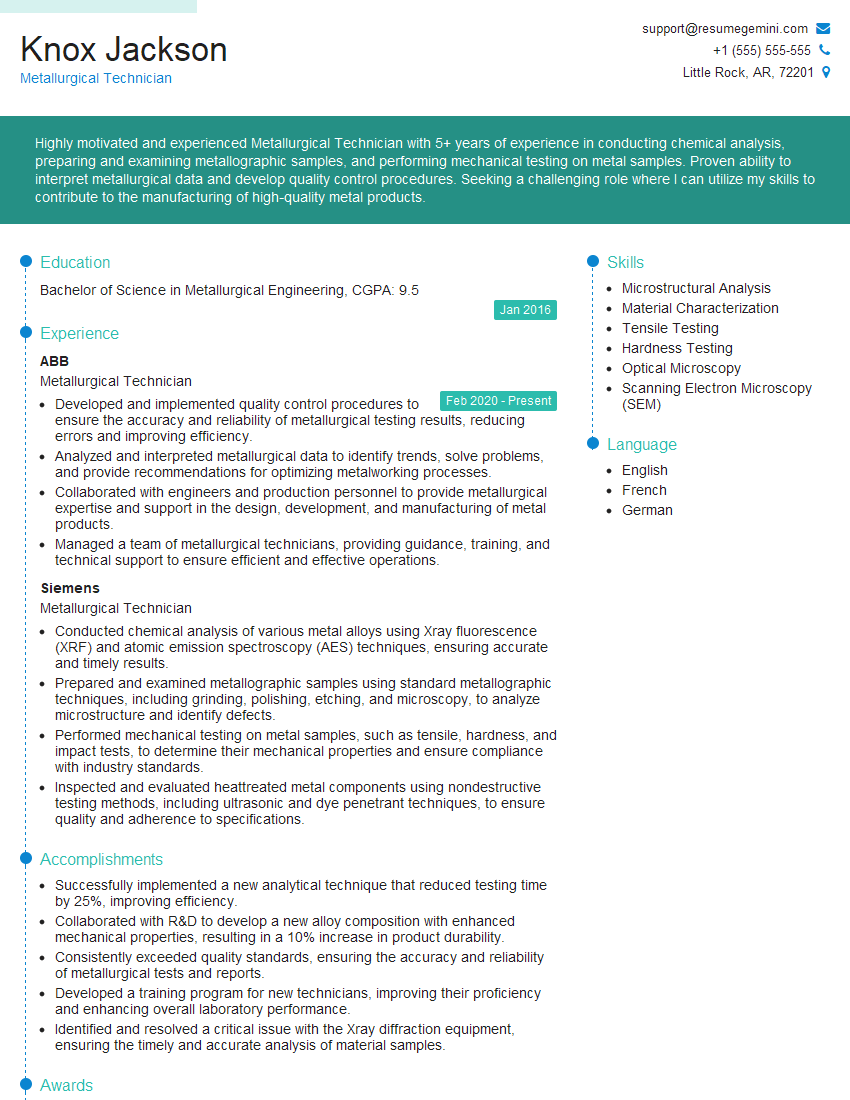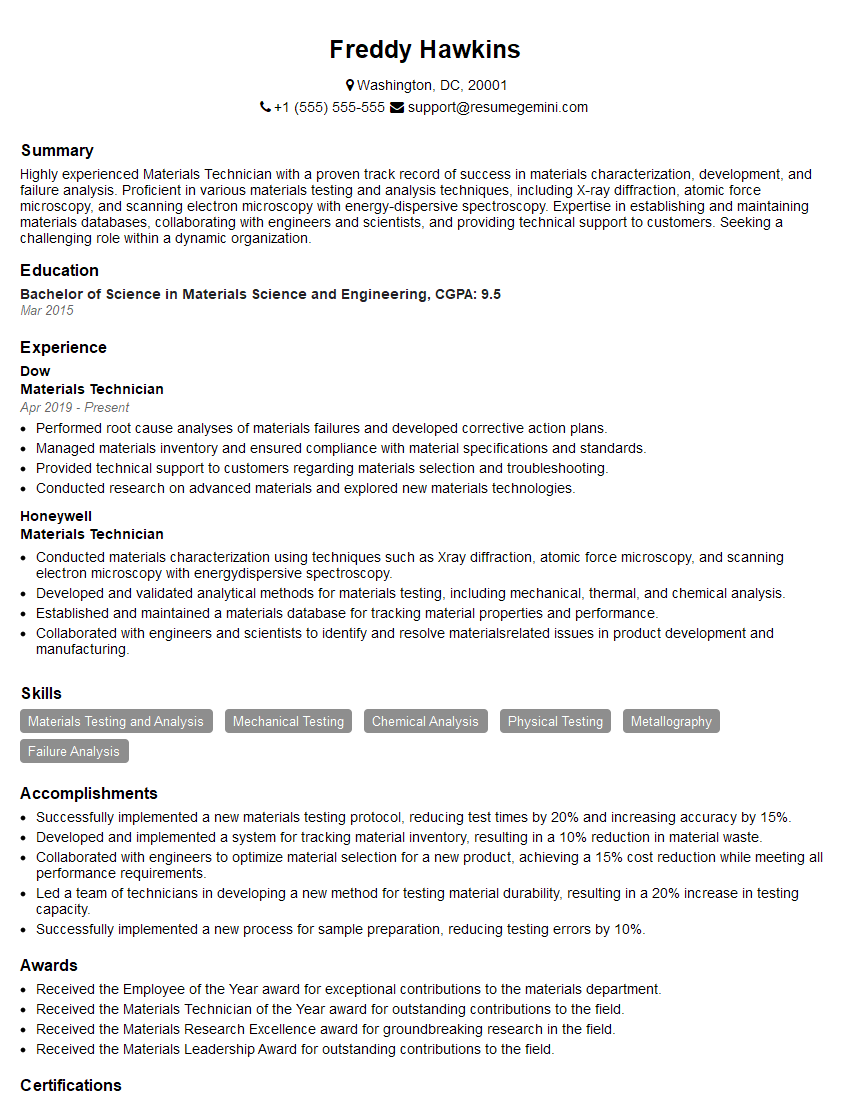Are you ready to stand out in your next interview? Understanding and preparing for Stress Relief Annealing interview questions is a game-changer. In this blog, we’ve compiled key questions and expert advice to help you showcase your skills with confidence and precision. Let’s get started on your journey to acing the interview.
Questions Asked in Stress Relief Annealing Interview
Q 1. Define stress relief annealing and its purpose.
Stress relief annealing is a heat treatment process designed to reduce internal stresses within a metal component. These stresses can arise from various manufacturing processes like welding, machining, or cold working. The purpose is to improve the part’s dimensional stability, reduce the risk of cracking or distortion, and enhance its overall performance and lifespan. Think of it like gently unwinding a tightly wound spring; the annealing process allows the metal to relax and reach a more stable state.
Q 2. Explain the difference between stress relief annealing and other annealing processes (e.g., full annealing, normalizing).
While all annealing processes involve heating and cooling a metal to alter its properties, they differ significantly in their goals and resulting microstructure. Stress relief annealing focuses solely on reducing residual stresses, leaving the material’s hardness and strength relatively unchanged. In contrast, full annealing aims to completely soften the metal, resulting in a softer, more ductile state. Normalizing is used to refine the grain structure and improve mechanical properties like strength and toughness, although it also reduces some stress. Imagine this: stress relief is like taking a deep breath to relax tense muscles; full annealing is like a full body massage that leaves you completely relaxed; normalizing is like a light workout that leaves you energized and refreshed.
Q 3. Describe the mechanisms by which stress relief annealing reduces residual stresses.
Stress relief annealing reduces residual stresses primarily through a process called recovery. During heating, the atoms within the metal gain enough energy to rearrange themselves, relieving internal distortions caused by the stresses. This is analogous to untangling a knotted rope by carefully loosening each knot. The higher the temperature and longer the holding time, the more complete the recovery process becomes. A secondary mechanism involves grain growth, where larger, more stable grains form, reducing stress concentrations at grain boundaries. This works a bit like rearranging tightly packed boxes in a warehouse, leaving more space and reducing the pressure on individual boxes.
Q 4. What factors influence the selection of the appropriate annealing temperature and time?
The selection of annealing temperature and time is crucial and depends on several factors: The material’s type (different metals require different temperatures), the level of stress needing to be relieved (higher stresses necessitate higher temperatures or longer times), and the desired final properties (avoiding excessive softening). The temperature should generally be below the recrystallization temperature of the material to prevent significant changes in mechanical properties. For instance, a highly stressed steel component might need a temperature between 540-650°C (1000-1200°F), while aluminum might require lower temperatures. The time depends on the material’s thickness and the desired stress reduction; thicker sections and higher stresses require longer soak times.
Q 5. How do you determine the optimal annealing cycle for a specific material and application?
Determining the optimal annealing cycle involves a combination of theoretical calculations, material data analysis, and experimental verification. First, consider the material properties and the type of residual stresses present. Then, use literature data and heat treatment charts for guidance on temperature and time. However, it’s essential to conduct experimental trials, involving precise measurements of residual stresses before and after annealing using methods such as X-ray diffraction or destructive testing. This iterative approach of testing, adjusting parameters, and testing again allows refinement towards the optimal cycle that achieves the desired stress reduction without compromising the material’s properties.
Q 6. Explain the importance of controlled cooling rates in stress relief annealing.
Controlled cooling rates are essential after stress relief annealing to minimize the introduction of new stresses. Rapid cooling can trap atoms in a high-energy state, potentially inducing new stresses. Therefore, a slow, controlled cooling rate, often furnace cooling, is preferred to allow the atoms to gradually rearrange themselves and minimize the formation of new stresses. Imagine cooling hot glass slowly to avoid cracking; the controlled cooling of the metal serves a similar purpose.
Q 7. What are the potential consequences of inadequate stress relief annealing?
Inadequate stress relief annealing can lead to several detrimental consequences: Dimensional instability (warping, distortion), reduced fatigue life (premature failure under cyclic loading), increased risk of cracking (especially in brittle materials), and unexpected failure under service conditions. For example, in a welded pressure vessel, insufficient stress relief can cause cracking during operation, leading to catastrophic failure. In a precision machining application, residual stresses can cause parts to deform after the heat treatment, leading to high scrap rates. Thus, proper stress relief annealing is a critical step to ensure the reliability and performance of many engineering components.
Q 8. How do you verify the effectiveness of stress relief annealing?
Verifying the effectiveness of stress relief annealing involves assessing whether the residual stresses in a material have been reduced to an acceptable level. This isn’t a simple yes/no answer; it depends heavily on the application and allowable stress limits. We typically employ a combination of methods to paint a complete picture.
- Mechanical Testing: Techniques like tensile testing can reveal changes in yield strength and ductility after annealing. A reduction in yield strength, coupled with increased ductility, suggests successful stress relief. For example, if a part initially showed high yield strength due to welding stresses, and after annealing, the yield strength decreases toward the expected value for the base material, it indicates effective stress reduction.
- Non-Destructive Testing (NDT): NDT methods, discussed in more detail in the next question, provide crucial insights without damaging the component. They offer a more comprehensive assessment of residual stress distribution throughout the material.
- Dimensional Stability Measurements: Monitoring dimensional changes before and after annealing can help determine if internal stresses causing warping or distortion have been significantly alleviated. Think of a welded structure: after annealing, warpage might be considerably less.
- Comparison with Baseline Data: Ideally, establishing a baseline of residual stresses before annealing is crucial. This allows for a quantifiable comparison to measure the effectiveness of the process. This could involve initial NDT measurements before the annealing process.
Ultimately, the effectiveness is judged against the specific requirements of the application. A part intended for high-precision applications might require a more rigorous reduction in residual stress than one used in less demanding situations.
Q 9. Describe common non-destructive testing methods used to evaluate residual stress.
Common non-destructive testing (NDT) methods for evaluating residual stress include:
- X-ray Diffraction (XRD): XRD measures the lattice spacing changes within the crystalline structure of the material. Changes in lattice spacing directly relate to the level of residual stress. It’s particularly useful for surface stress measurements.
- Neutron Diffraction: This technique penetrates deeper into the material than XRD, allowing for bulk residual stress analysis. It’s often employed for thicker components where surface measurements aren’t sufficient.
- Hole Drilling Method: A small hole is drilled into the material, and the resulting strain relaxation is measured. This strain relaxation is directly related to the initial residual stress. It’s relatively straightforward and widely used.
- Strain Gauge Method: Strain gauges are attached to the surface of the material, and the strain changes are monitored as the material is relieved of stress. This method is suitable for measuring surface stresses.
- Ultrasonic methods: Changes in ultrasonic wave velocity can be correlated to residual stress. This is a versatile technique that can be adapted for various material types and geometries.
The choice of NDT method depends on several factors, including the material type, component geometry, and the desired depth of analysis. Often a combination of methods is used to obtain a more complete understanding of the residual stress state.
Q 10. What are the limitations of stress relief annealing?
While stress relief annealing is highly effective, it has limitations:
- Grain Growth: High annealing temperatures can lead to excessive grain growth, potentially reducing the material’s strength and ductility. This is a trade-off: reducing stress might compromise other properties.
- Over-Annealing: Excessive annealing can result in softening the material beyond acceptable limits, leading to unwanted deformation or decreased performance. Careful control of time and temperature is essential.
- Oxidation and Decarburization: At elevated temperatures, materials can oxidize or lose carbon (decarburization), particularly on the surface. This can alter the material’s properties and introduce surface defects.
- Cost and Time: Annealing requires specialized equipment (furnaces) and precise control of temperature and time, increasing costs and processing time.
- Not Suitable for All Materials: Certain materials might exhibit undesirable phase transformations or other changes at the annealing temperatures required for stress relief.
- Incomplete Stress Relief: Highly complex geometries or materials with extremely high residual stresses might not achieve complete stress relief, even with optimized annealing cycles.
Understanding these limitations is crucial for selecting appropriate annealing parameters and for managing potential drawbacks.
Q 11. How does the material’s microstructure influence the stress relief annealing process?
The material’s microstructure significantly impacts the stress relief annealing process. The size, shape, and distribution of grains affect how readily stresses can be relieved.
- Grain Size: Finer-grained materials generally exhibit faster stress relief because of more grain boundaries, which act as pathways for stress relaxation. Think of it like having more cracks through which the stress can escape.
- Grain Orientation: Preferred grain orientations (texture) can influence the anisotropic behavior of stress relief. The process might not be uniform in all directions.
- Phase Constituents: The presence of different phases in the microstructure can affect the diffusion processes involved in stress relaxation. Some phases might hinder stress relief while others may facilitate it.
- Pre-Existing Defects: Microstructural defects like dislocations and vacancies act as stress concentrators and influence how the material responds to annealing. These defects affect the rate at which stress is relieved.
Therefore, understanding the microstructure of a material is crucial for optimizing the annealing cycle. Microscopic examination of the material before and after annealing can provide valuable insights into the effectiveness of the process.
Q 12. Discuss the influence of alloying elements on stress relief annealing.
Alloying elements significantly influence stress relief annealing. They affect several aspects of the process:
- Solid Solution Strengthening: Alloying elements in solid solution increase the material’s resistance to stress relaxation. This means that it might require higher temperatures or longer annealing times to achieve the same level of stress relief.
- Phase Transformations: Certain alloying elements can promote or suppress phase transformations during annealing, which directly impact the final microstructure and residual stress level. For example, adding certain elements might cause a phase transformation that helps release stress.
- Diffusion Rates: Alloying elements can affect the diffusion rates of atoms, influencing how quickly stresses can be relieved. Slower diffusion rates lead to slower stress relief.
- Oxidation Resistance: Some alloying elements improve oxidation resistance, reducing the risk of surface degradation during annealing at high temperatures.
For instance, comparing low-carbon steel to high-carbon steel, the higher carbon content in high-carbon steel results in greater strength but also means that a higher temperature or longer time might be required for effective stress relief annealing.
Q 13. Describe the effect of different heating methods (e.g., furnace, induction) on annealing.
Different heating methods impact the annealing process primarily through their heating rate, temperature uniformity, and ability to penetrate the material.
- Furnace Heating: Offers excellent temperature uniformity across large volumes, making it suitable for batch annealing of multiple parts simultaneously. However, heating and cooling rates are typically slower.
- Induction Heating: Provides rapid heating, leading to shorter annealing cycles, but can result in less uniform temperature distribution, especially in complex geometries. It’s often used for localized heating or specific applications.
- Resistance Heating: Involves passing a current through the material itself to generate heat. It can provide good control over heating rates but is limited to electrically conductive materials.
- Laser Heating: Offers extremely precise localized heating, ideal for specific areas of stress relief, but requires sophisticated control systems and is often limited by the size of the component.
The optimal heating method depends on the specific material, component geometry, desired heating rate, and overall annealing goals. For large components requiring uniform heating, a furnace might be preferred. For smaller components where speed is crucial, induction heating might be more suitable. The heating method selection is an important design consideration for the whole process.
Q 14. Explain how to interpret a stress-strain curve related to annealing.
A stress-strain curve obtained from tensile testing before and after annealing provides valuable information about the effectiveness of the stress relief process.
- Yield Strength: A reduction in yield strength after annealing indicates successful stress relief. The yield strength should move closer to the expected value for the base material in the absence of residual stresses.
- Tensile Strength: Tensile strength might show a slight decrease after annealing, particularly if over-annealing occurred. This is not necessarily indicative of a failed annealing process, it depends on the specific materials and goals.
- Ductility: An increase in ductility (elongation or reduction in area) after annealing confirms the stress relief. Higher ductility suggests a more relaxed material and less likelihood of brittle failure.
- Elastic Modulus: The elastic modulus (Young’s modulus) typically remains unchanged after stress relief annealing, as this is a fundamental material property that isn’t significantly affected by stress levels.
By comparing the stress-strain curves before and after annealing, you can quantify the change in material properties and directly assess the effectiveness of the stress relief achieved. A larger change in yield strength and increase in ductility point to a successful annealing cycle.
Q 15. What are the safety precautions necessary during stress relief annealing?
Safety during stress relief annealing is paramount. It’s crucial to treat the process with the respect it deserves given the high temperatures involved and the potential for hazardous situations. My approach emphasizes a multi-layered safety strategy.
- Proper Personal Protective Equipment (PPE): This includes heat-resistant gloves, safety glasses or a face shield, long sleeves, and closed-toe shoes. Ignoring this is simply unacceptable.
- Safe Furnace Operation: Understanding the furnace’s controls and emergency shut-off mechanisms is essential. Regular inspections of the furnace’s integrity (looking for cracks or leaks) before each operation are critical.
- Material Handling: Using proper lifting techniques and equipment to handle hot materials is crucial to prevent burns and injuries. Never attempt to move heavy objects alone.
- Ventilation: Adequate ventilation is necessary to remove any toxic fumes produced during the annealing process, especially when dealing with certain alloys. This often involves exhaust systems and proper workspace ventilation.
- Emergency Procedures: A clear emergency plan should be in place, including procedures for fire, burns, or other incidents. All team members should be trained on these procedures. I insist on regular fire safety drills to ensure preparedness.
- Lockout/Tagout Procedures: Before any maintenance or repair work on the furnace, proper lockout/tagout procedures must be followed to prevent accidental energization.
For example, in a previous role, we implemented a color-coded system for furnace operation indicating safe operating temperature ranges. This visual cue significantly improved safety compliance among the team.
Career Expert Tips:
- Ace those interviews! Prepare effectively by reviewing the Top 50 Most Common Interview Questions on ResumeGemini.
- Navigate your job search with confidence! Explore a wide range of Career Tips on ResumeGemini. Learn about common challenges and recommendations to overcome them.
- Craft the perfect resume! Master the Art of Resume Writing with ResumeGemini’s guide. Showcase your unique qualifications and achievements effectively.
- Don’t miss out on holiday savings! Build your dream resume with ResumeGemini’s ATS optimized templates.
Q 16. Describe your experience with different types of furnaces used in annealing.
My experience spans various furnace types used in stress relief annealing, each with its strengths and weaknesses. The choice depends on factors like the size and type of components, desired heating rates, and budget constraints.
- Batch Furnaces: These are the most common, particularly for smaller-scale operations. They’re relatively inexpensive to purchase and operate but have lower throughput compared to continuous furnaces. I’ve used both electric and gas-fired batch furnaces, carefully monitoring temperature uniformity within the chamber. Maintaining accurate temperature profiles is a key challenge.
- Continuous Furnaces: Ideal for high-volume production, these furnaces process materials continuously on a conveyor belt. They offer higher throughput and better process control but require significantly higher capital investment. I’ve worked with several types of continuous furnaces in the automotive industry and found their precise control of heating and cooling critical for maintaining consistent quality in mass-produced parts.
- Vacuum Furnaces: Used for specialized applications requiring a controlled atmosphere, these furnaces eliminate oxidation. They are more expensive and complex to operate but are indispensable when preserving material properties is paramount. My experience with vacuum annealing focuses on aerospace components where minimizing oxidation is crucial.
Selecting the right furnace type is a critical decision during the planning stage of a project. It requires careful consideration of several factors to ensure efficient and safe operation.
Q 17. How do you troubleshoot common problems encountered during stress relief annealing?
Troubleshooting stress relief annealing problems requires a systematic approach. My strategy involves a combination of observation, data analysis, and process adjustments.
- Temperature Uniformity Issues: Inconsistencies in temperature can lead to uneven stress relief. I’d check thermocouple calibration, furnace insulation, and the component loading arrangement. Modifications like improved insulation, more strategic placement of thermocouples, or changes to the loading pattern can usually solve this.
- Oxidation or Decarburization: This is often due to insufficient control of the atmosphere within the furnace. Employing protective atmospheres, vacuum annealing, or adjusting the furnace’s atmosphere control systems are solutions.
- Incomplete Stress Relief: This points to insufficient time at the annealing temperature or an incorrect temperature profile. Adjustments to the annealing cycle, including both temperature and dwell time, would be investigated and refined. Data analysis of previous successful cycles is invaluable in this process.
- Part Distortion: This could indicate improper support or uneven heating. Re-evaluating the component loading arrangement within the furnace and exploring better fixturing options are steps to take.
For instance, in one project, we identified an unexpected temperature gradient in a batch furnace. By adjusting the heating element arrangement and adding insulation, we significantly improved temperature uniformity, resulting in a more consistent stress relief across all components. I always stress the importance of meticulous record-keeping to facilitate effective troubleshooting.
Q 18. Explain the role of automation in stress relief annealing processes.
Automation plays a transformative role in modern stress relief annealing, enhancing efficiency, consistency, and safety.
- Programmable Logic Controllers (PLCs): PLCs manage the entire annealing cycle, including temperature control, atmosphere regulation, and data logging. Precise control over the heating and cooling rates ensures consistent results.
- Data Acquisition Systems (DAS): DAS collect and monitor numerous parameters (temperature, pressure, atmosphere composition) throughout the process. This enables real-time process monitoring, which can be crucial for preventing issues and ensuring optimal performance.
- Robotics: Robots automate material handling, loading, and unloading of components, improving efficiency, reducing human intervention near the high-temperature furnace, and improving safety.
- Closed-Loop Control: Automation enables closed-loop control, where feedback from sensors is used to adjust the process parameters dynamically and keep the process within the desired parameters. This improves the consistency of the final product and reduces waste.
In my experience, implementing automation led to a significant reduction in processing time, improved consistency in stress relief, and a marked reduction in human error. It’s not just about speed; it’s about achieving consistent quality in a controlled and safe environment.
Q 19. How do you maintain the quality and consistency of the annealing process?
Maintaining quality and consistency in the annealing process involves a comprehensive approach that combines careful process control, regular monitoring, and preventative maintenance.
- Calibration and Verification: Regular calibration of thermocouples, pressure sensors, and other instrumentation is vital. This ensures the accuracy of the data collected and the reliability of the process control system. Verification of furnace performance through controlled tests needs to happen frequently to guarantee that the heating rates and uniformity are within acceptable limits.
- Process Monitoring and Data Analysis: Continuous monitoring of key parameters (temperature, time, atmosphere) allows for early detection of deviations from the desired process parameters. Statistical Process Control (SPC) charts help monitor the process and identify areas for improvement. This proactive approach can often avert major problems.
- Preventative Maintenance: Regular maintenance of the furnace and associated equipment is crucial to prevent malfunctions and ensure long-term reliability. Following a scheduled maintenance program is critical. The more proactive your approach the less likely you are to face unscheduled shutdowns.
- Material Characterization: Regular testing of the annealed materials through techniques like tensile testing or hardness testing helps in confirming the effectiveness of the stress relief process and the achievement of desired mechanical properties. This feedback loop ensures the overall quality is where it should be.
A detailed example is our implementation of a computerized maintenance management system (CMMS). This system tracks maintenance schedules, facilitates proactive repairs, and contributes to the overall reduction of unplanned downtime. A well-maintained system is essential for consistent, high-quality output.
Q 20. Discuss the economic considerations associated with stress relief annealing.
The economic considerations of stress relief annealing are multifaceted, involving capital investment, operating costs, and the impact on product quality.
- Capital Expenditure (CAPEX): The initial investment includes the cost of the furnace, ancillary equipment (e.g., material handling systems, control systems), and installation. The choice of furnace type significantly impacts CAPEX. A continuous furnace, for instance, has high initial costs but often yields greater returns in high-volume production.
- Operating Costs (OPEX): These include energy consumption (electricity or gas), maintenance, labor, and materials (protective atmospheres). Energy efficiency of the furnace and effective maintenance strategies are crucial for reducing OPEX.
- Impact on Product Quality: Proper annealing can significantly improve product quality, reducing defects and improving the final product’s performance and lifetime. This translates into reduced warranty costs and improved customer satisfaction. However, improper annealing can lead to product failure and costly rework.
- Return on Investment (ROI): A comprehensive cost-benefit analysis is essential for determining the overall economic viability of the annealing process. Factors like production volume, product value, and the cost of defects must be carefully considered. I often use ROI analysis to justify investments in upgraded equipment or automation.
For example, in one project, we compared the ROI of two furnace options. While the initial investment for the continuous furnace was higher, the higher throughput and reduced energy consumption led to a significantly faster payback period, making it the economically superior choice in the long run.
Q 21. Describe your experience with statistical process control (SPC) in annealing processes.
Statistical Process Control (SPC) is an integral part of ensuring quality and consistency in our annealing processes. It provides a data-driven approach to process monitoring and improvement.
- Control Charts: We routinely use control charts (e.g., X-bar and R charts) to monitor key process parameters such as temperature, time, and resulting material properties. These charts help in identifying trends and detecting any deviations from the target values.
- Process Capability Analysis: This analysis helps in determining the ability of the annealing process to meet the specified requirements. It helps to identify potential limitations in the process and prioritize areas for improvement.
- Data Collection and Analysis: Comprehensive data collection is essential for effective SPC. We use automated data acquisition systems to collect data continuously. Regular analysis of this data provides valuable insights into the process behavior and helps in identifying root causes of variations.
- Continuous Improvement: SPC is not just about monitoring; it’s a tool for continuous improvement. By identifying and addressing variations, we can fine-tune the annealing process to optimize quality and minimize defects.
A specific example is our use of control charts to monitor the hardness of annealed components. By analyzing these charts, we were able to identify a pattern of increasing hardness variation that was traced back to a problem in the furnace’s temperature controller. The timely identification and correction of this issue prevented significant quality problems downstream. The data-driven nature of SPC empowers informed decision-making, resulting in a more consistent and reliable process.
Q 22. How would you handle a situation where the annealed material doesn’t meet specifications?
If annealed material fails to meet specifications, a systematic investigation is crucial. We start by reviewing the entire process: verifying the initial material properties, confirming the accuracy of the annealing cycle parameters (temperature, time, atmosphere), and inspecting the equipment for malfunctions.
For example, if the material exhibits residual stresses, it might indicate an insufficient annealing time or temperature. We might need to increase either parameter slightly, closely monitoring the outcome. If the problem persists, it could point to an issue with the furnace’s temperature uniformity; a thorough calibration and potentially maintenance would be necessary. A metallurgical analysis might be needed to identify microstructural changes, such as grain growth or phase transformations, that might indicate an unsuitable cycle for the material.
We might also need to consider alternative annealing techniques, such as vacuum annealing or controlled atmosphere annealing, if the current method is inadequate. Each adjustment requires meticulous documentation, data analysis, and potentially iteration until the specifications are met.
Q 23. What are the environmental considerations related to stress relief annealing?
Stress relief annealing’s environmental impact is primarily linked to energy consumption and potential emissions. The energy used to heat the furnace contributes to greenhouse gas emissions. The choice of atmosphere also plays a crucial role: some processes utilize inert gases like argon, which have a lower environmental impact than others. However, even inert gas usage means energy is needed to produce and transport the gas.
Furthermore, depending on the material being annealed, there might be emissions released during the process itself. For instance, annealing certain alloys might lead to the release of volatile compounds. Therefore, responsible annealing practices involve optimizing energy usage through efficient furnace design, selecting environmentally friendly atmospheres, and implementing rigorous emission control measures if necessary.
Q 24. Explain how you would develop a new stress relief annealing cycle for a novel material.
Developing a new annealing cycle for a novel material requires a careful, iterative approach. It begins with a thorough understanding of the material’s properties: its melting point, thermal conductivity, coefficient of thermal expansion, and susceptibility to various phase transformations. This information guides the initial cycle design.
We might start with small-scale experiments using differential scanning calorimetry (DSC) and dilatometry to study the material’s response to heat. This allows us to identify suitable temperature ranges and heating/cooling rates. Then, we’ll perform trial annealing cycles on small samples, carefully measuring the resulting residual stress levels using techniques like X-ray diffraction. This is followed by adjusting the parameters (time, temperature, atmosphere) based on the test results. Each iteration is documented to optimize the process and achieve the desired stress relief without compromising material properties. The goal is to find a cycle that balances effective stress reduction with time and energy efficiency.
Q 25. Describe your experience with documenting and reporting annealing process results.
Documentation and reporting are paramount in stress relief annealing. Every annealing cycle should be meticulously recorded, including parameters like temperature profile, time at temperature, atmosphere used, and batch identification. Critical data points, such as the material’s initial properties and post-annealing residual stress levels measured by techniques such as X-ray diffraction or residual stress measurement equipment, are carefully documented. All this is recorded in a secure database and linked to the respective batch identification. For traceability and quality assurance, a unique identifier is generated for each batch.
Reporting is usually tailored to the specific needs, but typically it will include a summary of the annealing process parameters, the material properties before and after the annealing, and the measured residual stress level with a comparison against the specifications. This detailed approach guarantees accurate process tracking and facilitates troubleshooting or process optimization. Visual aids such as graphs illustrating the temperature profile are very useful for quick understanding of the annealing cycle.
Q 26. Discuss the impact of different atmospheres (e.g., vacuum, inert gas) on annealing.
Different atmospheres significantly impact annealing. Vacuum annealing minimizes oxidation and decarburization, crucial when processing reactive metals. Inert gas annealing (using argon or nitrogen) provides a protective atmosphere, preventing oxidation and other undesirable chemical reactions. In contrast, controlled atmosphere annealing might involve adding specific gases to manage the chemical environment. For example, annealing in a reducing atmosphere might be beneficial for specific materials.
The choice of atmosphere often depends on the material and the desired outcome. For instance, vacuum annealing might be preferred for high-value components where even minimal oxidation is unacceptable, while inert gas annealing might suffice for less critical applications. The atmosphere choice adds cost and requires specialized equipment, so careful assessment of these parameters is crucial for selecting the most efficient annealing method.
Q 27. How would you choose between different annealing methods for a particular application?
Selecting an annealing method depends on several factors, including the material type, desired stress relief level, dimensional tolerances, and production scale. For instance, furnace annealing is a common method for large batches, but continuous annealing is better suited for high-volume production lines. Vacuum annealing is ideal for high-precision parts sensitive to oxidation, whereas controlled atmosphere annealing offers flexibility for managing specific chemical reactions.
Think of it like choosing a cooking method – you wouldn’t bake a steak the same way you’d bake a cake. Similarly, the optimal annealing method is determined by the material’s properties and the specific requirements of the application. A thorough analysis considering all factors will lead to the most effective and efficient approach.
Q 28. What are the latest advancements in stress relief annealing technology?
Recent advancements in stress relief annealing include the development of more energy-efficient furnaces, using technologies like induction heating or advanced control systems to better manage temperature profiles. Laser annealing is gaining traction for precise, localized stress relief. It’s particularly beneficial for delicate or complex components. Advances in process monitoring and automation enhance reproducibility and quality control, contributing to increased accuracy and efficiency.
Furthermore, the use of advanced modeling and simulation techniques provides more accurate predictions of annealing outcomes, potentially reducing the number of experimental iterations needed for cycle optimization. These advancements are driven by the demand for higher quality, more precise control, and enhanced sustainability in the manufacturing processes.
Key Topics to Learn for Stress Relief Annealing Interview
- Fundamentals of Annealing: Understand the basic principles behind heat treatments and their impact on material properties.
- Stress Relief Annealing Process: Describe the different stages, temperature control, and time considerations involved in the process.
- Material Selection and Suitability: Discuss the types of materials best suited for stress relief annealing and the reasons behind their selection.
- Practical Applications: Explain real-world applications of stress relief annealing in various industries (e.g., manufacturing, aerospace).
- Equipment and Techniques: Familiarize yourself with the different types of furnaces and equipment used, along with various annealing techniques.
- Quality Control and Testing: Understand the methods used to ensure the effectiveness of the stress relief annealing process and identify potential issues.
- Residual Stress Measurement: Describe methods used to quantify and analyze residual stresses before and after annealing.
- Troubleshooting and Problem Solving: Be prepared to discuss common problems encountered during stress relief annealing and their solutions.
- Safety Considerations: Demonstrate understanding of safety protocols and precautions related to high-temperature processes.
- Economic Considerations: Discuss the cost-effectiveness of stress relief annealing and its impact on overall production efficiency.
Next Steps
Mastering Stress Relief Annealing opens doors to exciting career opportunities in materials science, manufacturing, and engineering. A strong understanding of this process significantly enhances your value to potential employers. To maximize your job prospects, creating an ATS-friendly resume is crucial. ResumeGemini is a trusted resource to help you build a professional resume that effectively showcases your skills and experience. Examples of resumes tailored to Stress Relief Annealing are provided to help you get started. Invest the time to craft a compelling resume—it’s your first impression with potential employers.
Explore more articles
Users Rating of Our Blogs
Share Your Experience
We value your feedback! Please rate our content and share your thoughts (optional).
What Readers Say About Our Blog
good

